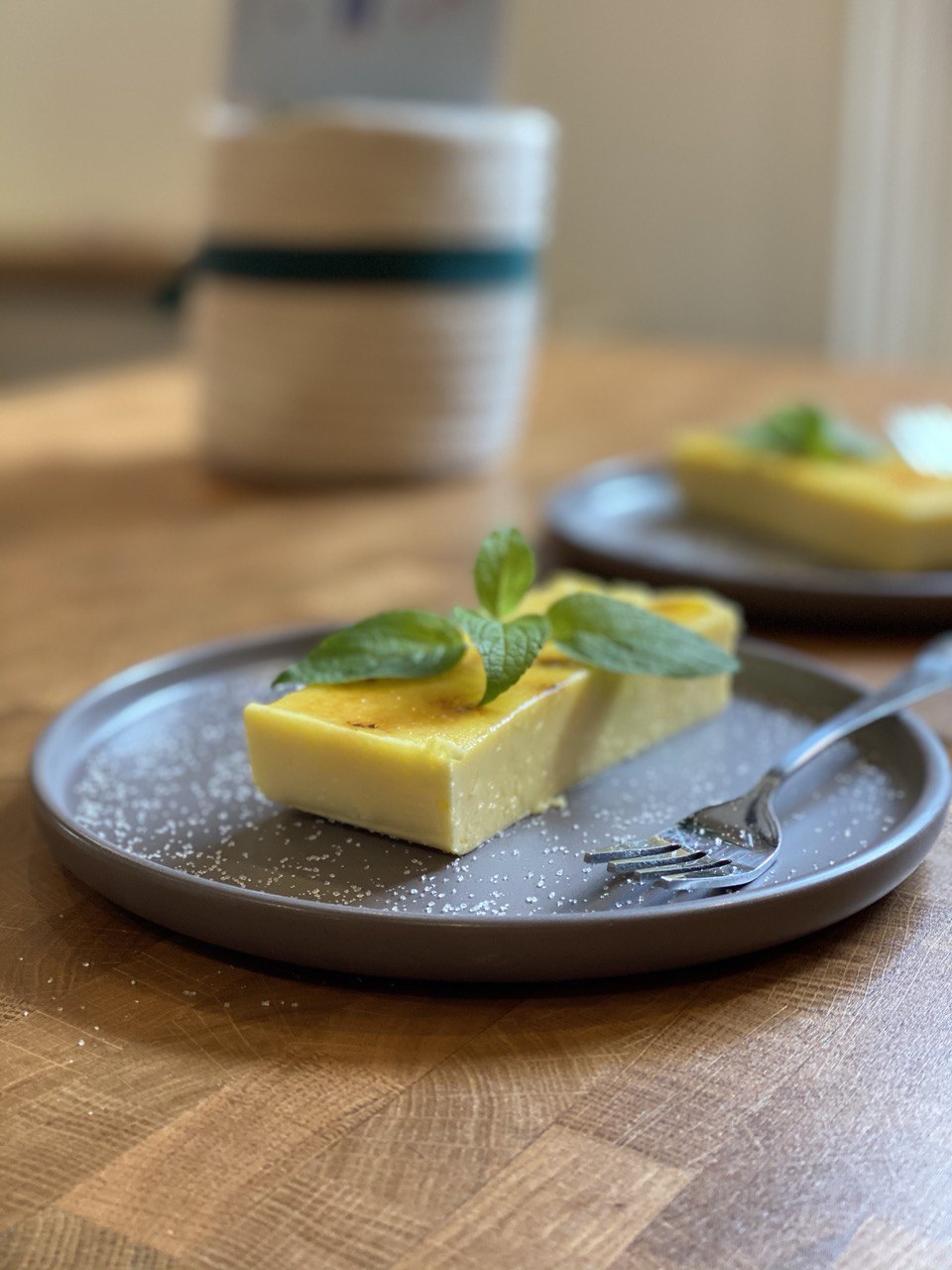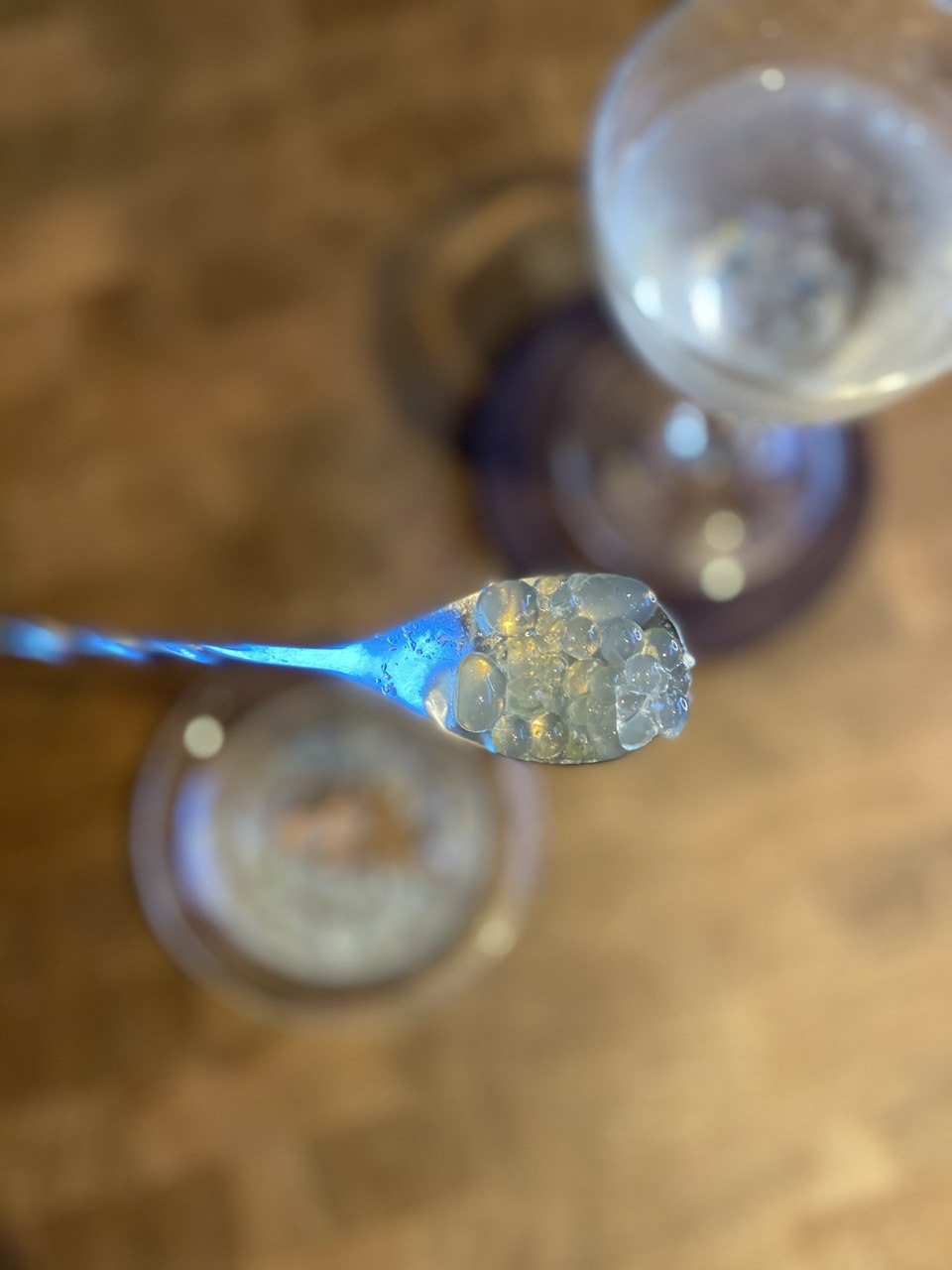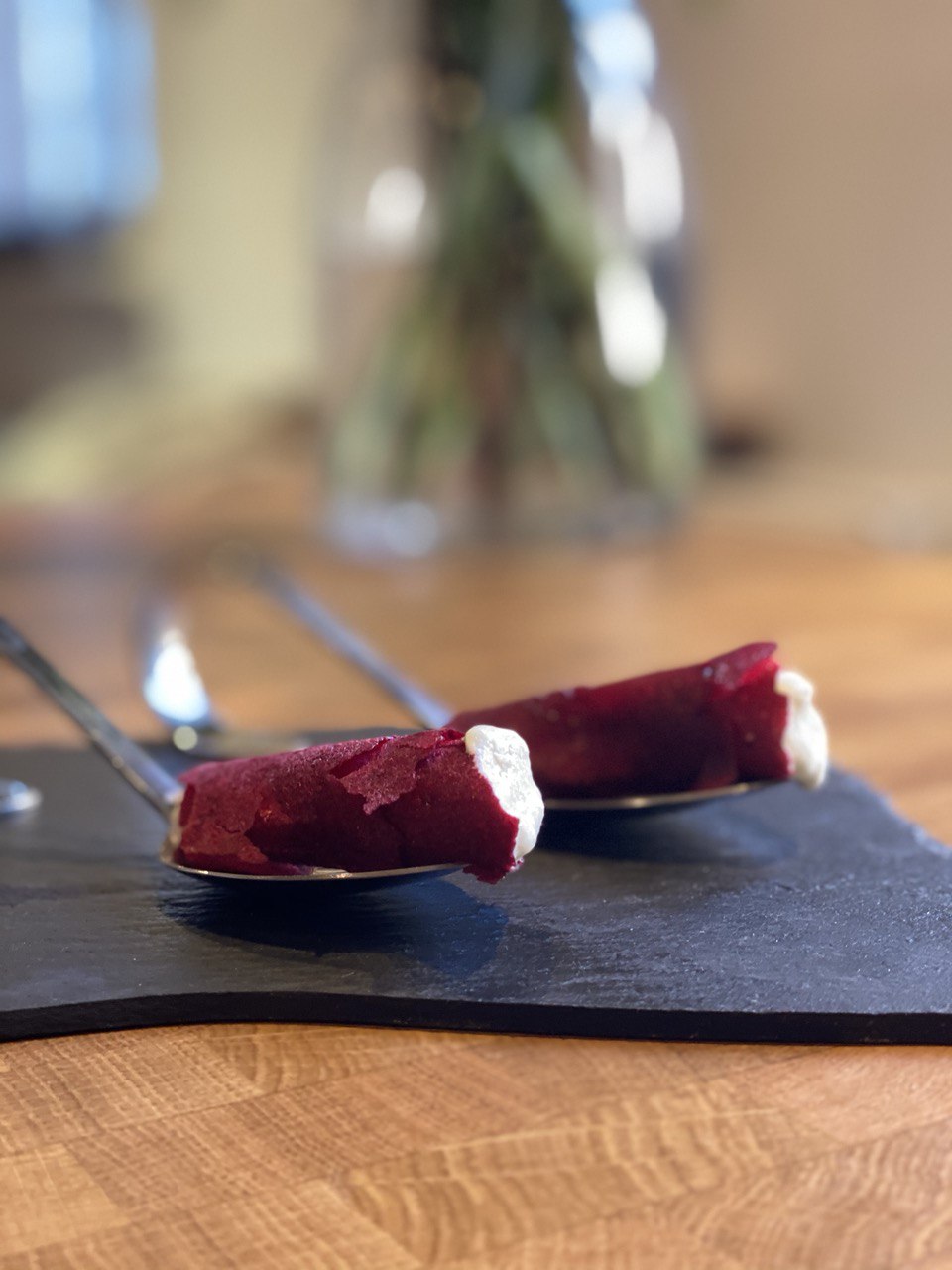Tuesday Triage #21
- TUESDAY TRIAGE #21 by Vadim Drobinin
- On celebrations
- Freeform crème brûlée
- Dirty Martini with Olive Brine caviar
- Scallops, pea purée, and cumin foam
- Coco-Hazulnut Fondant
- Cranberry tuile and Stilton foam
- Kir Royale with Creme de Cassis pearls
- Things I enjoyed reading
- 1. The Appealing and Potentially Lethal Delicacy That Is Fugu by Ligaya Mishan
- 2. How to Make Your Code Reviewer Fall in Love with You by @deliberatecoder
- 3. I tried the world's first no-kill, lab-grown chicken burger by @olireports
- 4. M1 Macs: Truth and Truthiness by @daringfireball
- 5. Math keeps changing by @tmcw
- 6. An oral history of the hamburger icon (by the people who were there) by @dlaebe
- 7. LinkedIn’s Alternate Universe by @fadeke_adegbuyi
- 8. A Comprehensive Guide to App Pricing Strategies and Tools by Zachary Shakked
- 9. The body as mediator by @the_sky_above
- 10. My Phone Was Spying on Me, so I Tracked Down the Surveillants by @martingund
- Things I didn't know last Tuesday
- 1. Tsar Peter the Great’s statue in London
- 2. Curry in Japan
- 3. Cemetery of Soviet computers
- 4. Kaktovik Iñupiaq numerals
- 5. Liechtenstein on AirBnb for £43,000
- 6. en dash vs em dash
- 7. 7-UP's history
- 8. Nobel disease
- 9. Shakespeare's signatures
- 10. Kilted soldiers
- Book of the week
- Thank you and see you in a week!
TUESDAY TRIAGE #21
by Vadim Drobinin ¶
Your weekly crème de la crème of the Internet is here!
08.12.2020 (read in browser)
On celebrations ¶
This week was (and is!) Sasha's birthday, and given the year we live in I opted out of going to a restaurant and decided to cook a few things myself.
Cooking per se is fun but it is not special on its own.
We make it special by either cooking something very rare, or by embodieng customs into specific dishes, or by bringing a specific experience to the plate.
I decided to cook six molecular cuisine courses inspired by Michelin-starred chefs, and seems like it went really well:
Freeform crème brûlée ¶

Inspired by Hervé This from Institut National de la Recherche Agronomique, I wanted to make a light morning dessert but with quick plating and an unusual twist. Crème brûlée melts when glazed with a torch, hence it is usually served in ramekins. Here I use a mix of hydrocolloids to fix it without altering the taste.
Dirty Martini with Olive Brine caviar ¶

For an aperitif I served Dirty Martini with olive brine caviar, based on a technique invented by Ferran Adrià for El Bulli. Spent a day freezing olive oil and then pouring brine into it drop by drop.
Scallops, pea purée, and cumin foam ¶

Inspired by Chris Horridge from The Bath Priory. An interesting takeaway: pea puree looses its colour very fast, so needs to be boiled in milk, and then strained out, blended, and dilluted with hot milk it was boiling in. After that I had to cool it down very fast, and then brought the temperature back by pouring hot cumin foam on top.
Coco-Hazulnut Fondant ¶

A wonderful palate cleanser, based on Thomas Raquel's recipe for Le Bernardin. The glazing on top was made out of Frangelico liqueur, but overall it's pretty much coconut milk and agar-agar, so is terrifyingly vegan.
Cranberry tuile and Stilton foam ¶

Probably my favourite: thanks to Heston Blumenthal's idea for The Fat Duck. I couldn't find isomalt required for making the tuile, so had to boil cranberry in red wine to reduce, and then mixed in some liquid glucose, and left in the oven for a few hours to turn into flexible sheets. The foam was done in an espuma gun from melted Stilton cheese and double cream.
Kir Royale with Creme de Cassis pearls ¶

And last but not least, a festive upgrade to mere Champagne: the Kir Royale cocktail. Instead of simply pouring Creme de Cassis liqueur into Champagne, I turned the former into solidified pearls, following the aformentioned Ferran Adrià's technique.
All in all, it was a great experience and I am really looking forward to the next opportunity to mix some hydrocolloids in the kitchen.
Things I enjoyed reading ¶
1. The Appealing and Potentially Lethal Delicacy That Is Fugu by Ligaya Mishan ¶
Here is a great overview of fugu as both dish and tradition. I had a chance to try it a few times in my life, and never really had enough interest to order one, partly because of its potential lethality, mostly because I do not particularly enjoy eating fish in most forms. However, after delving into fugu's history I most likely will reconsider my attitude.
Has the art of preparing fugu — of quietly, methodically dividing death from delight — entered its own slow fade? We live at a moment when many regard binaries as a form of resistance: wild versus farmed; natural versus industrial; an individual, idiosyncratic restaurant versus a chain of infinitely replicable ones.
Just take a moment of appreciation and listen to the sound of "quietly, methodically dividing death from delight".
This is writing the way it should be.
2. How to Make Your Code Reviewer Fall in Love with You by @deliberatecoder ¶
One of the most helpful things I've learnt over the years of perfecting intricacies of working in teams was the art of properly preparing pull requests for code reviews.
The fastest way to ruin a code review is to take feedback personally. This is challenging, as many developers take pride in their work and see it as an extension of themselves. If your reviewer tactlessly frames their feedback as a personal attack, it’s even harder.
As the author, you ultimately control your reaction to feedback. Treat your reviewer’s notes as an objective discussion about the code, not your personal worth as a human. Responding defensively will only make things worse.
This is a very detailed look into things one could do to make everyone's life slightly better.
3. I tried the world's first no-kill, lab-grown chicken burger by @olireports ¶
I don't particularly enjoy plant-based burgers. Personally, this is one of the hills I am willing to die on: vegetarians are missing out on one of the most pleasant experiences of their lifes. However, on the scale from plant burgers to properly smashed beef burgers I consider chicken to be almost vegetarian-friendly, and this is another confirmation to my theory.
Unlike reared poultry, this meat is made bespoke. It can be significantly altered in the process, depending on how it is encouraged to grow (in any shape) and what it is used in the “feed” – the water, sugar, amino acid, protein and vitamin bath the meat grows in.
This can lead to surprising possibilities. “We can have something that is between a breast and a thigh,” says Halevy. Meat from animals that are endangered could be cultured without harming them, he adds.
Don't take me wrong though: I would love to have an opportunity to grow or print out every single ingredient for a dish at home, and completely ditch shady corner shops, or being able to get a piece of steak from a flask and turn it into a tartare without worrying about its safety.
Obviously, as far as it tastes and smells like meat. And has a meaty texture. And holds memories of eating green grass and running in the fields (surely it makes meat taste better?).
4. M1 Macs: Truth and Truthiness by @daringfireball ¶
Can't deny the temptation to buy one of the new Macs. I don't really need it as a workstation: my Mac is maxed out, and M1 doesn't support a plenty of apps I use daily.
Those machines are just standing around in their underwear now because the M1 stole all their pants. Well, that just doesn’t happen, your instincts tell you. One company, even a company like Apple, doesn’t just embarrass the entire rest of a highly-competitive longstanding industry. But just because something hasn’t happened — or hasn’t happened in a very long while — doesn’t mean it can’t happen. And in this case, it just happened.
I would love to buy it as a device for traveling around. Long battery life and great performance are great.
The only sad bit is that it doesn't heat up properly anymore, so doesn't really make sense in winter. I was equally sad the year they've decided to deprecate a glowing logo.
5. Math keeps changing by @tmcw ¶
Here is to the way modern technologies affect how we think about math (and more importantly, apply it to our day-to-day lifes):
Our current tech stack is heavily optimized and a lot of optimizations are really just dirty tricks. For example, the number of hardware instructions it takes to solve Math.sin varies based on the input, because there are lots of special cases. When you get to more complex cases, like ‘sorting an array’, there are often multiple algorithms that the interpreter chooses between in order to give you your final result. Basically, the cost of anything you do in an interpreted language is variable.
And yet, it doesn't really remove the importance of learning the logic behind these "dirty tricks".
6. An oral history of the hamburger icon (by the people who were there) by @dlaebe ¶
There are battles; there are Battles.
One of my Battles is the hamburger icon, as for almost a decade I try to explain folks around that it doesn't really work for iOS apps. Sometimes you might think that it does, but this rarely has any support via data.
What many don’t know, however, is how this tiny symbol is a direct portal into the beginnings of personal computing, the place where it all started. I spoke with three of the people who were there—Cox, David Canfield Smith, and Ralph Kimball—about how the hamburger came to be, the heady days of the Xerox Star’s inception and what the best design thinking (the kind that yields 40-year old symbols still going strong) looks like.
At least now I know the names of those responsible for it.
I wrote them down.
7. LinkedIn’s Alternate Universe by @fadeke_adegbuyi ¶
One of my favourite morning pre-coffee routines is to open Linkedin and browse through "friend" requests and random messages I get from people I don't know and won't want to know. The way they speak is very different from any other platform; the way they post articles and memes feels like an art film.
What’s uniquely odd about LinkedIn is that it is not unique. “The professional network” is still just a social network. Though the topics of the posts in your timeline may be on the world of work, diving into the comments, you can see polarization in action. Inspirational posts on giving parents grace while working from home during the pandemic have angry rants suggesting that kids are a personal choice and their burden shouldn’t be foisted upon colleagues.
Check out the whole article for a plenty of beautiful examples of such communications. Or just open Linkedin's feed and I am pretty sure you will get the same.
8. A Comprehensive Guide to App Pricing Strategies and Tools by Zachary Shakked ¶
To me, app pricing is a totally overlooked part of an app's release cycle. I never paid much attention to it and usually went with the flow; it didn't work they way it would if I were to approach it properly.
First, design your tests to be robust and scientific. Randomly decide which user gets the cheaper price or which users only get offered weekly. Give your tests enough time to run and conduct a thorough analysis of the data. Always remember to consider statistical significance for everything you’re testing.
Some might argue about the moral side of finding the most well-performing price but to me it's a yet another way to bring the best user experience by optimising every single part of their flow, and the monetization part is often the most annoying, so why not let them vote with their conversions?
9. The body as mediator by @the_sky_above ¶
I absolutely love that my living the moment phylosophy has followers; namely, Maurice Merleau-Ponty from France.
The notion of being present in the here and now, rather than getting caught up in the nonstop chatter of the mind, offers us a natural way to ‘live and breathe’ Merleau-Ponty’s philosophy. He wrote, in particular, of the importance of adopting an ‘attentiveness and wonder’ towards the world. To engage with the world phenomenologically, he suggested, we must embrace being ‘a perpetual beginner’: coming back again and again to what we perceive before us, remaining ‘open to the adventures of experience’.
10. My Phone Was Spying on Me, so I Tracked Down the Surveillants by @martingund ¶
This is not a surprise for anyone somehow related to the engineering field. If something could be tracked, it will be eventually.
As one wise man said, "software is eating the world" -- some companies just scavenge around.
I have a feeling these apps are spying on me. Well, not listening in, but that they’re keeping track of where I am at all times. That my every move is shared on. When I am shopping for groceries, having a drink, or hanging out with friends.
I know there are those that buy and sell such information. How are they tracking us, and what do they want with our data?
Things I didn't know last Tuesday ¶
1. Tsar Peter the Great’s statue in London ¶
I didn't know that there is a Tsar Peter's statue in London:

The statue was erected in 2000, it was designed by Mihail Chemiakin (sculptor) and Viacheslav Bukhaev (Architect).
A gift from the people of Russia, it commemorates Tsar Peter the Great’s visit to London.
You might be a bit surprised by the dwarf and the size of the Peter's head unless you've seen other statues of Mihail Chemiakin. Namely, his other statue of Peter The Great in St. Petersburg:
2. Curry in Japan ¶
Well yes, I should have expected this after learning about chicken tikka masala's origin (I briefly touch on it being a British dish in the 11th edition of the newsletter), but who would have guessed that curry is something Western too?
British people brought curry from the Indian colony back to Britain and introduced it to Japan during the Meiji period (1868 to 1912), after Japan ended its policy of national self-isolation (sakoku), and curry in Japan was categorised as a Western dish.
3. Cemetery of Soviet computers ¶
These pictures remind me of my school years: not because my classrooms looked remarkably similar (they actually didn't) but thanks to my occasional school trips to plants around the city -- some of them were pretty much the same.
Part of the cabinets were antique electronic computers. Others served to measure signals, and computers controlled this process. Dozens of terminals froze on the tables with extinct screens.


The title links to an English translation, but there are more photos in the original Russian post right here.
4. Kaktovik Iñupiaq numerals ¶
We are quite used to Arabic numeral notation and take for granted that base-2 works well with it too. What'd we do if our languages had a bigger base?
Students from Kaktovik, Alaska invented a base-20 numeral notation in 1994 to rectify this issue, and this system spread among the Alaskan Iñupiat and has been considered in other countries where Inuit languages are spoken.
Apparently, wait for hundreds of years and then come up with something like this:

5. Liechtenstein on AirBnb for £43,000 ¶
In 2010 anyone could rent a country at AirBnb for a fairly reasonable price.
The principality of Liechtenstein has decided to make itself available to private clients, from $70,000 (£43,000) a night, complete with customised street signs and temporary currency.
The price includes 150 guest, renaming streets, and wine-tasting with the monarch.
Sounds like a nice plot for a movie.
6. en dash vs em dash ¶
I knew about different dashes, but never though about origins of their names. Spoiler alert: it has the same roots as putting two spaces after a period.
the en dash is the width of the letter “n”, while the em dash is the width of the letter “M”.
7. 7-UP's history ¶
In my childhood I used to love 7-UP a lot, mostly because it was nearly transparent hence felt less poisonous comparing to other sodas.
It contained lithium citrate, a mood-stabilizing drug, until 1948
Probably if I were to drink it until 1948 it'd be my favourite drink anyway, but not because of its (lack of) colour.
Also all myths about its name are hilarious.
A myth exists that the 7 Up name comes from the drink having a pH over 7. That would make it neutral or basic on the scale; however, this is not the case, as the 7 Up pH is close to 3.79, making it acidic on the pH scale and similar to other drinks of this type. [...]
The real origin of the name is unclear, though Britvic claims that the name comes from the seven main ingredients in the drink, while others have claimed that the number was a coded reference to the lithium contained in the original recipe, which has an atomic mass around 7.
However, this one makes the most sense to me:
Britvic also claims that the name is a result of the fact that 7 Up was bottled in 7-ounce bottles (Coca-Cola and most other soft drinks were bottled in 6-ounce bottles).
8. Nobel disease ¶
A nice way to express one's suspicion of an authority.
Nobel disease is a phenomenon where a Nobel Prize-winning scientist endorses or performs "research" in pseudoscientific areas in their later years, generally (though not always) after having won the esteemed prize for some legitimate scientific achievement.
Though the biggest surprise to me was the selection of Nobel Prize winners who had this "disease", e.g Marie Curie supported a psychic medium or Luc Montagnier believes in homeopathy.
9. Shakespeare's signatures ¶
There are six Shakespeare's signatures out there:

And they all look different.
The spelling of William Shakespeare's name has varied over time. It was not consistently spelled any single way during his lifetime, in manuscript or in printed form. After his death the name was spelled variously by editors of his work, and the spelling was not fixed until well into the 20th century.
10. Kilted soldiers ¶
Aye, these names are killing me with kilts.
In the United Kingdom, “pigs in blankets” refers to small sausages (usually chipolatas) wrapped in bacon though in Scotland they are often called kilted soldiers.
And extra trivia:
Pigs in blankets can be followed with devils on horseback, an appetiser of prunes wrapped in bacon
Such a lovely menu for a Christmas dinner, innit.
Book of the week ¶
As you might have noticed already, this week was all about thinking of flavours, and partly by reading Karen Page's "The Flavor Bible":
It was through our study of wine that we developed an appreciation for the critical role of understanding a wine’s body, or weight—and, in turn, the relative weights of various foods. In fact, weight has eclipsed color as the key factor in pairing wine with food.
Weight and season often go hand in hand, as we crave lightness in summer and heavier dishes when temperatures fall. In summer, that craving for lightness could be satisfied with a salad of fresh greens topped with shrimp or chicken and tossed in a vinaigrette. Our winter cravings for more substance and warmth might lead us to a hearty stew made with red meat and root vegetables in their own thick sauce.
This is a very powerful thought.
Wine's body is no secret to me, and yet I never thought to apply the same spectrum to food.
When I think about light, medium and heavy ingredients (the same way we think about light vs full-bodied wines), apples feel less "heavy" than bananas to me, same applies to chicken vs venison.
And once the weight is accounted for, ingredient pairings get more exciting and yet balanced.
Thank you and see you in a week! ¶
If you have any questions, or want to suggest a link for the next newsletter, please drop me a message on Twitter or reply to this email.
Cheers! 🍸